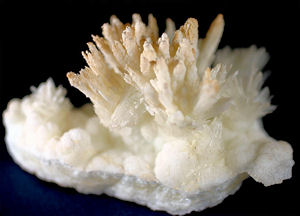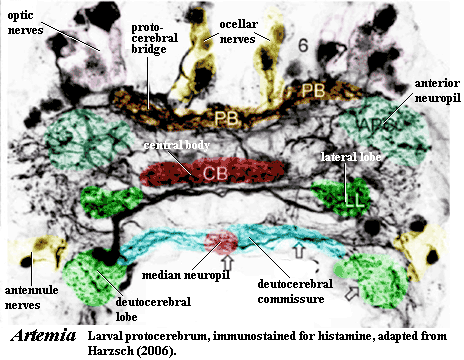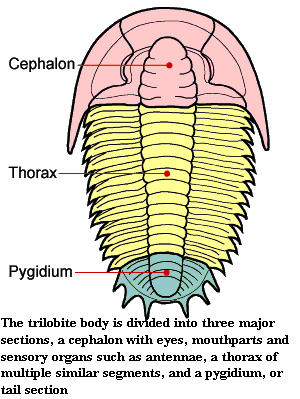
All material by ATW may be used under the terms of a
Public Domain Dedication.
| Glossary | ||
| Metazoa | Glossary C |
| Metazoa | |||||
| Life | Time |
|
Life
├─Eubacteria
└─┬─Archaea
└─Eukarya
├─Chlorobionta
└─┬─Fungi
└─Metazoa
├─Choanoflagellata
└─Porifera
├─Radiata
└─┬─Cnidaria
└─Bilateria
├─Deuterostomia
└─Protostomia
├─Ecdysozoa
└─Spiralia
|
The eventual aim is to combine all the glossaries distributed throughout the metazoan section. This will takes many years. |

calcareous containing calcium. Unless the context dictates otherwise, it implies calcium carbonate (calcite).
calcite (geochemistry, biochemistry) one of the two crystal forms of calcium carbonate commonly found in nature. See aragonite for more information. The image (from the Colorado Gem & Mineral Co.) shows needles of aragonite emerging from a calcite matrix.
calthrop (sponge anatomy) a four-pointed spicule (tetractine) with all four branches of roughly equal size.
carbonic anhydrase (general biochemistry) an enzyme which catalyzes the formation of carbonate from carbon dioxide and water.
carcinology the study of crustaceans.

central body In arthropod neuroanatomy, a median neuropil in the protocerebrum, associated with optic and/or olfactory processing. The central body is quite large in crustaceans and insects and is associated with other neural structures unique to insects and non-branchiopod crustaceans.

cephalon arthropod anatomy) The head. Anterior region of the body bearing the antennules (in Crustacea), antennae, eyes, and mandibles.
-cerite (crustacean anatomy) a suffix applied to limb elements, suggesting that the element is part of an antenna or antennule.
choanocyte (sponge anatomy) choanocytes choano = collar; cyte = cell) are cells which bear "a collar of tentacles surrounding a single anterior flagellum. Undulation of the flagella of thousands of choanocytes creates a current of water that is drawn in from outside the animal, passes through the internal chambers and is expelled through an exhalant opening. Choanocytes are responsible for transporting oxygen-rich water to the internal cavity of the sponge and for bringing food particles, particularly bacteria, to the surface of the collars where they can be ingested." Leadbeater (2001).
choanoderm (sponge anatomy) sponge endoderm analogue. The choanoderm is lined with choanocytes.
Chuar Group: Neoproterozoic of northern Arizona (USA), with exposures along the Grand Canyon. Composed of the Galeros and Kwagunt Formations older to younger). The upper limit is constrained to be about 742 My old. Porter & Knoll (2000).
cinctoblastula sponge embryology. The characteristic larva of Homoscleromorpha, cells with paracrystalline intranuclear inclusions that form a belt around the posterior pole. Leys & Erevskosky (2006).
clade a natural group, i.e., a group consisting of a particular organism and all of its descendants, i.e. a monophyletic group. Example: Dinosauria, defined as the last common ancestor of Triceratops and Corvus (the crow) and all of its descendants.
coenosteum in stromatoporoid (sponge) anatomy, the calcitic skeleton.
collagen the major insoluble fibrous protein in the extracellular matrix and in connective tissue. It is the single most abundant protein in Metazoa. There are at least 16 types of collagen, but types I, II, and III predominate. These collagen molecules pack together to form long thin fibrils. Type IV, in contrast, forms a two-dimensional reticulum. The various collagens and the structures they form all serve the same purpose, to help tissues withstand stretching. The basic structural unit of collagen is a triple helix. The triple-helical structure of collagen is produced by the characteristic repeating motif Gly-Pro-X, where X can be any amino acid. Each amino acid has a precise function. The side chain of glycine, an H atom, is the only one that can fit into the crowded center of a three-stranded helix. Hydrogen bonds linking the peptide bond NH of a glycine residue with a peptide carbonyl (C═O) group in an adjacent polypeptide help hold the three chains together. (quoted, with slight modifications, from Lodish et al., 2000).
collagen, type IV The characteristic collagen of the basement membrane. "The type IV collagen molecule is a long triple helix containing several interruptions, which is characterized by a specific carboxyl-terminal, non-collagenous NC1 domain. Among the six different α chains (numbered 1 to 6) of type IV collagen it is generally assumed although not definitely demonstrated) that the more frequent molecular stoichiotry is of two αl, α3 or α5 chains for one α, α4 or α6 chain, respectively." Boute et al. 1996).
collencyte (sponge biology) a cell which is specialized to produce collagen.
coxa the most proximal segment of a crustacean appendage. See image at protopod. See Dr. Joel Martin's Crustacea Glossary for details and exceptions.
cruciform in the shape of a cross.
cruciform cells (sponge development) four specialized, possibly photosensitive cells, one in each quadrant, near the equatorial plane of certain calcareous sponge embryos. Amano & Hori (2001); Leys & Degnan (2001).
cryptic habitat in ecology, a class habitat in which the organism is largely enclosed, including underground burrows, caves, under rocks, within the shells of other dead or living organisms, etc.
Page by: ATW070805
Last revised: ATW071025
Checked ATW070725